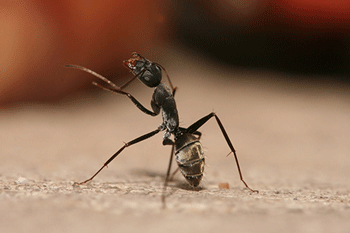Why Do I Have Carpenter Ants in My House?
By Chris Williams on July 21, 2014.
 You keep seeing those large black ants wandering around your kitchen. You’ve finally figured out that they are carpenter ants and now you’re worried about whether they are damaging your home. Where did they come from?
You keep seeing those large black ants wandering around your kitchen. You’ve finally figured out that they are carpenter ants and now you’re worried about whether they are damaging your home. Where did they come from?
If you’ve had a positive identification of carpenter ants from an exterminator, you may already know that there are two possibilities: (1) the ants are nesting outside and just foraging into your house looking for food, or (2) the ants are nesting inside your house. In this second case, they could still be foraging outside for food, or they could be getting most of their food from your kitchen.
It’s not always easy to tell where the ants are nesting. An exterminator can inspect, tracking the ants and looking for their nest sites. If the ants are nesting in your home, you may have seen some clues such as small piles of “sawdust” on surfaces underneath infested wood.
You May Have Invited the Ants In By Supplying:
- Water-damaged Wood – Carpenter ants don’t eat wood like termites do, instead they use their mandibles to carve out nest galleries inside the wood. It’s a lot easier to do that job if the wood has been softened by moisture or decay. If your home has had roof leaks, or plumbing leaks, or drainage problems, you may have water-damaged or wet wood and not even know it. Even though carpenter ants prefer to start their nests in rotting wood, they can then move into sound wood.
- Available Food – Whether carpenter ants are nesting inside your house or moving in from outside, if you supply food…they will come. Outside, carpenter ants feed on insects and plant juices, including the honeydew excreted by plant-feeding aphids. If their outside food supplies dwindle, carpenter ants will increase their foraging looking for a replacement food source. If a wandering carpenter ant gets into your home and finds available food like sweets, grease, crumbs, pet food, it will soon recruit other ants to share in the bounty. If you are being bothered by foraging ants of any kind, it’s very important to remove accessible food and clean up kitchen spills.
If your indoor carpenter ants are seasonal (just during warm weather months), that’s a clue that they may be foraging in from outside to collect food. But if you see carpenter ants in your home in the winter, that almost certainly means that they are nesting inside. In either case, you will want to eliminate them from your home. Call Colonial, we’ll send out one of our carpenter ants experts right away.
For more on carpenter ants in your home, check out these informative Colonial blogs:
- Finding the Source of Carpenter Ants
- Will These Ants Start A Nest Inside My House?
- Carpenter Ants in Winter
- Carpenter Ants Prefer Damp Wood
- Sawdust Piles Could Mean Carpenter Ants
- How Serious Are Carpenter Ants?
“Camponotus flavomarginatus ant” by Muhammad Mahdi Karim (www.micro2macro.net) Facebook – Own work. Licensed under GFDL 1.2 via Wikimedia Commons.